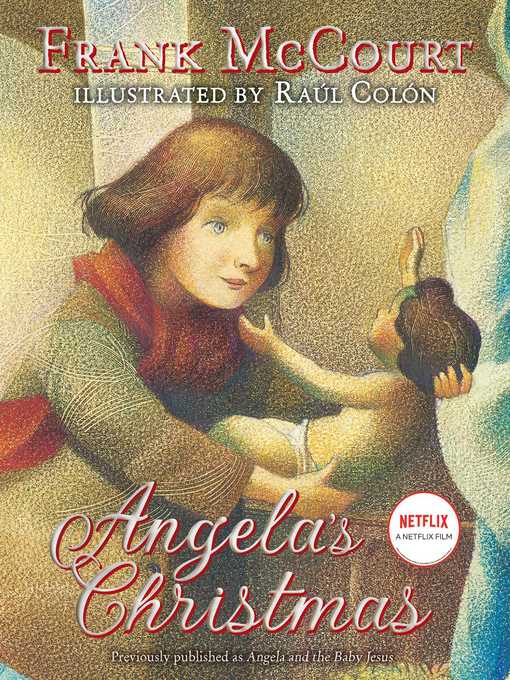
Angela and the Baby Jesus
فرمت کتاب
ebook
تاریخ انتشار
2007
Lexile Score
680
Reading Level
2-3
ATOS
4.1
Interest Level
K-3(LG)
نویسنده
Raúl Colónناشر
Scribnerشابک
9781416579199
کتاب های مرتبط
- اطلاعات
- نقد و بررسی
- دیدگاه کاربران
نقد و بررسی

Starred review from October 22, 2007
Not one but two editions suffice to publish this sure crowd-pleaser by the celebrated McCourt, inspired by a childhood experience of the mother made famous in Angela's Ashes
. The plot can be reduced to anecdote: six-year-old Angela worries that the Baby Jesus feels cold in the crèche at the church, so she devises a way to smuggle him home and warm him. In McCourt's hands, however, the story opens a child's view onto a vast world that takes scant notice of her, where “people passing by were not in the mood to be looking at a little girl carrying something white in the dark,” and where she is considered too young to have anything of interest to say, even at home. Angela negotiates with unmistakably childlike logic: frustrated at her difficulty in getting the Baby Jesus over the garden wall (an improvised part of her scheme), she scolds him with empty threats: “ 'Baby Jesus, I have a good mind to leave you there in Mrs. Blake's backyard.' But she couldn't. If God found out, he'd never let her have a sweet or a bun for a whole week.” Rarely, McCourt risks inviting a laugh at Angela's expense (Angela continues, “You're not to be flying around like an angel”), but otherwise he brings consummate skill to his layering of different types of authenticity (in Angela's thinking, in the reactions to the inevitable discovery of the Baby Jesus), and evokes a potent mix of emotions.
Given a traditional storybook format and charged with illustrating a children's edition, Colón (My Mama Had a Dancing Heart
) employs his signature, multi-step watercolor and lithograph pencil technique, patterning the colors and surfaces to suffuse the story with warmth and light. The effect stops just short of nostalgic, to hint at a timeless if imperfect past. Candles in the church, streetlamps, a barely seen fire in the hearth all bathe Angela in a steady glow that emphasizes the spiritual dimension of the story. No incidental players stroll into these scenes, and the focus remains on Angela; not even Angela's mother can be seen unobstructed.
Long, ranging far from his illustrations for The Little Engine That Could
and Toy Boat
, interprets the story with an almost foreboding air, as if giving a form to Angela's trepidation and awareness of her own insignificance. The adult edition, produced in a small, square gift format, suggests the atmosphere of Angela's Ashes
, beginning with the cover illustration of chimneys spewing smoke into an evening sky, and continuing with the stony palette of grays and blues rendered in grainy acrylics. Already dark pictures make dramatic use of shadow—sometimes to conceal, sometimes to announce a character's presence. Readers never see Angela's face, and most of the characters, too, are shown with their backs to viewers, sometimes from an even more distancing mid-air perspective. McCourt's humor seems harder to locate in this version; on the other hand, the tender ending comes as more of a surprise. All ages.

October 1, 2007
Gr 1-4-The Pulitzer Prize-winning author shares the story of how his mother, at the age of six, took the Baby Jesus from the church crèche because she feared that he was cold. Showing remarkable insight into the logic of childhood, McCourt chronicles the little girls struggle between right and wrong, her attempts to maintain secrecy, and her fear in the face of consequence. The interplay between Angela and her brother, Pat, is particularly touching, and the adults in the story react authentically to the youngsters innocence and compassion. Colóns textured watercolor and litho pencil illustrations are exactly suited to the tone of the story. Their slightly grainy, etched quality blends realism with romanticism in a way that evokes distant Ireland as it might appear in a memory. This is excellent storytelling on every level."Linda Israelson, Los Angeles Public Library"
Copyright 2007 School Library Journal, LLC Used with permission.

September 1, 2019
A reissue of McCourt's Irish Nativity story. Like his Pulitzer Prize-winning title, Angela's Ashes (1996), McCourt's picture book (first published in 2007 as Angela and the Baby Jesus) draws on his mother's life. Recently adapted as a Netflix animated film, the story is now rereleased with a new title. In both versions, Colón's delicate, sure watercolor, colored pencil, and lithograph pencil illustrations lend light and warmth to the story of a little girl's worry that the baby Jesus in her church's Nativity is cold. Filled with good intentions, she absconds with the figurine and hides it in her warm bed. Rich dialogue that captures the characters' Shannonsider brogue enlivens McCourt's storytelling while subtle characterization evokes tender familial dynamics. Angela's elder brother, Pat, characterized as mentally disabled, sees her with the baby Jesus and tells their mother, who initially says he has "a great imagination." Angela is upset when he persists and gives away her secret. Alarmed, but sure of her daughter's benevolence, Mammy marches the family to the church to return the baby Jesus, where they encounter the priest and a policeman searching for the thief. The resolution hinges on Pat's benevolence when he misunderstands the policeman's gentle ribbing that his sister will go to jail and offers himself in her stead. Warm indeed. (Picture book. 4-8)
COPYRIGHT(2019) Kirkus Reviews, ALL RIGHTS RESERVED.

























دیدگاه کاربران